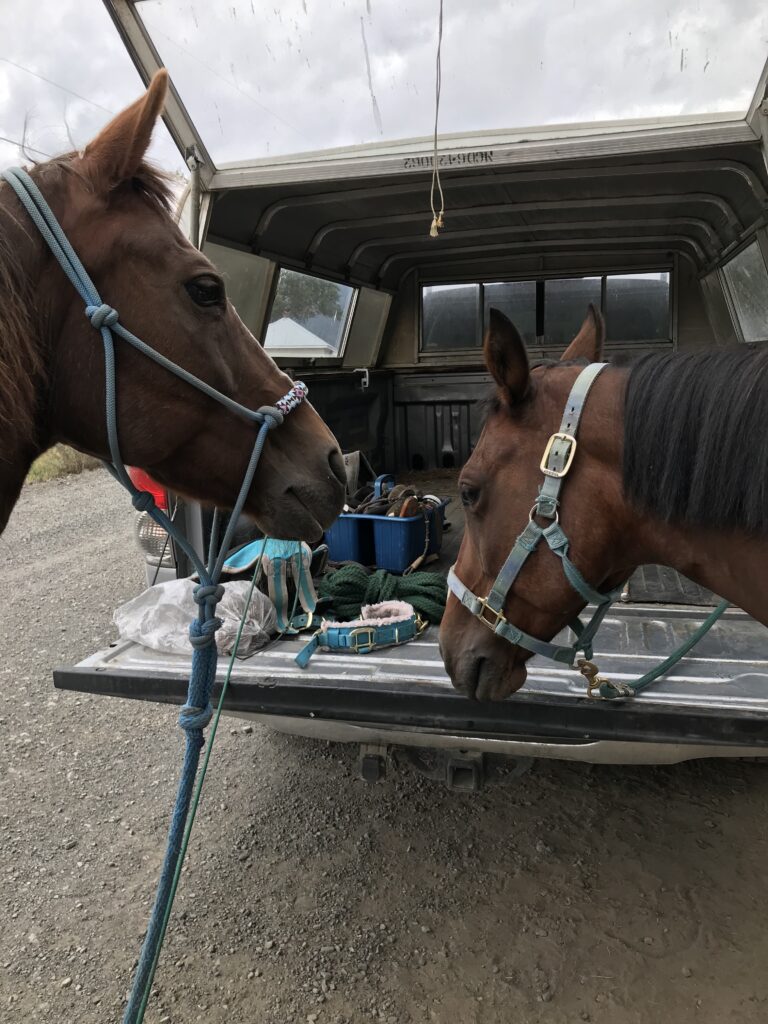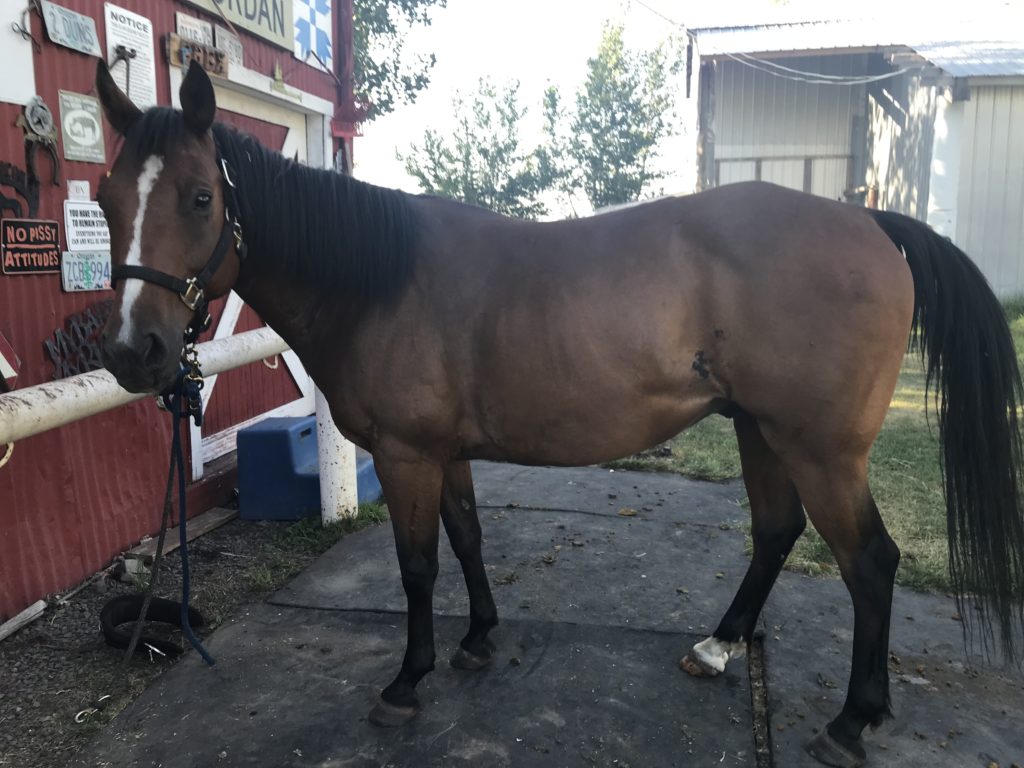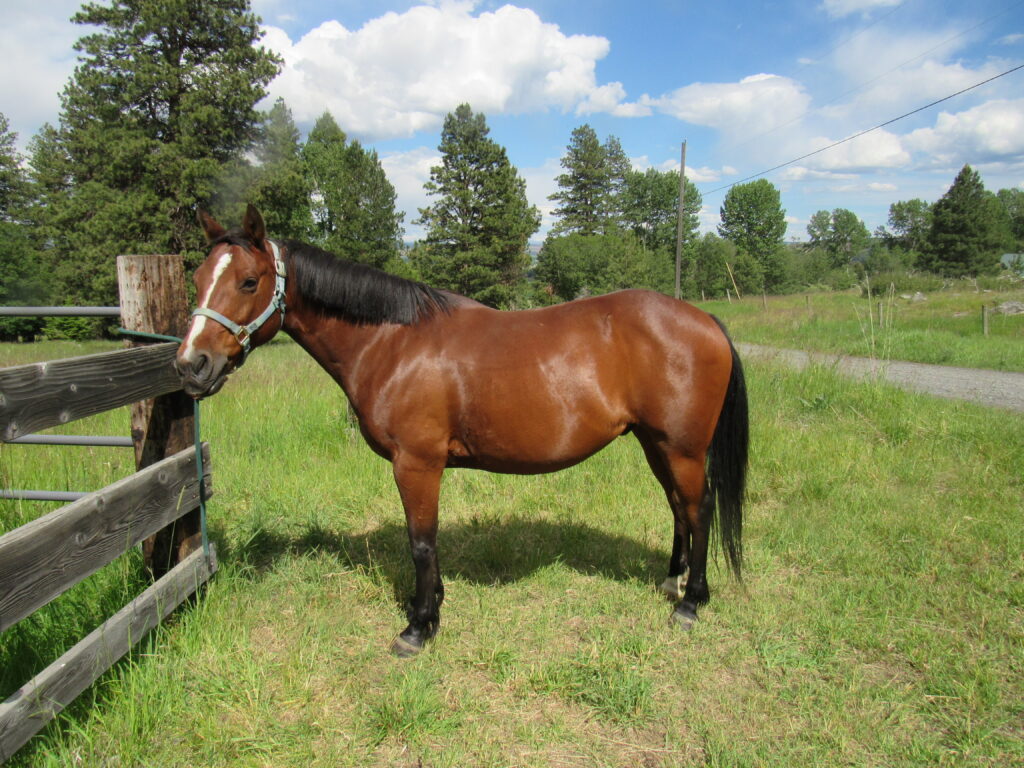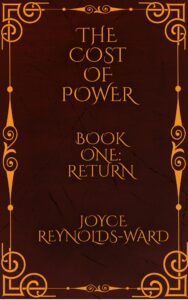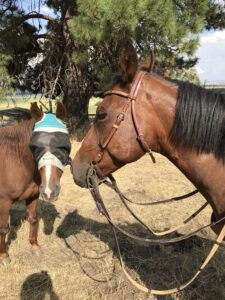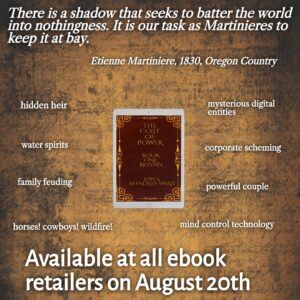I’ve been really satisfied with how things are going with the horses as we move into fall. Mocha is holding her weight nicely, and now that she gobbles up her supplement she’s starting to get a little shine on her coat. Though she’s still scratching on one of the junipers in the field…little telltale pieces of juniper branches in her mane give it away. She’s been providing a good example for Marker about standing behind the pickup for grain, grooming, and tacking.
And Marker boy is…making significant progress. Between the curb bit and me learning a little bit about the quirks of training gaited horses, he’s come a long ways. Oh, I still need to get firm with him about boundaries. He’s definitely a human-affectionate horse. Today when brushing him after our ride, he turned his head to rest the side of his nose against my leg and free hand while I brushed him. He likes to rest his chin on my shoulder at some point during the tacking and grooming, just about every time. I’m working on getting him to lick less because it becomes obnoxious after a while…then he turns it to licking the truck tailgate. A mouthy boy. Oh well, he’ll grow out of some of it. All the same, he’s very inquisitive about some things–today he decided he needed to supervise when I was putting on his front hoof boots. But–he stayed solid on all four feet even though his nose was six inches from the ground while I worked. Not something that Mocha could do.
Training him is vastly different from training Mocha. She really didn’t get warmed up and ready to roll until about thirty minutes or so into a ride. He doesn’t take as much warmup, plus he doesn’t do as well with intensive schooling as she did. It becomes pretty clear after a while when he’s hit the wall mentally, and giving him time to just gait along in his fox trot is the break he desires. It’s not so much a matter of endurance as it is mental overload, it seems. She had a greater mental tolerance for longer schooling sessions than he does. However, he also learns faster than she did. Today he made it clear to me that we didn’t need to two track before I asked him to canter; he’s picked up enough on the cues that I just need to weight the appropriate seatbone, bring the inside leg forward slightly, and touch him with the outside spur and he’ll launch quite appropriately into the correct lead from the walk or near-halt. It’s still a rough transition, but his anxiety about cantering is starting to fade. His fast canter can still pop me a little out of the saddle but uphill or the third set of canter he relaxes into a very nice rocking-horse canter. And as we refine the cues and work on softer, lighter signaling, he becomes less worried.
It’s just learning how to work with, as one gaited trainer says, the quadridextrous horse. I read an old-timer’s history about the Missouri Fox Trotter, and one of the old trainers flat-out said “don’t canter them until they’re solid in the fox trot.” Now that I know he’s gaited and that I need to approach some things differently, I really start understanding why he got so wound up earlier in training–it was a case that he couldn’t do some of the things I was asking of him, at least not until his conditioning was better and he was more solid in his gait. He still gets all mixed up about leg sequence if we don’t start from a walk or near-halt before asking to canter, which sometimes leads to a true trot that doesn’t feel right because he’s mixing it with fox trot and there’s that sensation of legs going everywhere. Asking him to stop, settle into a walk, then asking again really seems to help. While two-tracking helps him understand the cues for canter, he still gets tense about it, especially in one direction. But following Lee Ziegler’s direction of ask for canter from the flat walk, don’t canter very far, then let him gait as a reward really seems to have accelerated our progress in that as well as other areas.
He’s also getting more responsive to seat and leg. While I use vocal cues (cluck, kiss, and words), today he cantered without the kiss cue. He’s responding to weight shift and leg cues in serpentines. We’ve also been working on bending while going down the road in walk and fox trot.
Nice progress. Verbal praise also goes a long way with this horse…as does scolding him. Oh, he likes to play little tricks. Some of them, like grabbing for the grooming caddy, are clearly plays for attention, even negative attention. There are days when he is pure Trickster boy, and makes me glad I didn’t give him a Trickster name.
But then there are the days when he’s just chill and cuddly (at least as cuddly as a 1200 lbs horse can be), and just wants those little bits of attention.
It’s an interesting experience.
#
Shameless self promo here. I plan to send out my monthly newsletter soon which will have some announcements about sales and writing projects. You can subscribe to it here. As always, the Cookies Fund for the horses could use a coin or two. Contribute here. And The Cost of Power books are now all out in ebook and paperback–I hope to have the paperback links added soon, but for now, you can go to these links for a kickass science fantasy neoWestern with Carolingian elements. Click on each title for the link: Return, Crucible, Redemption.

